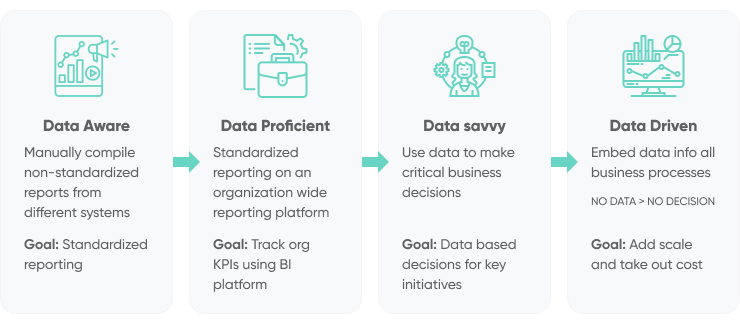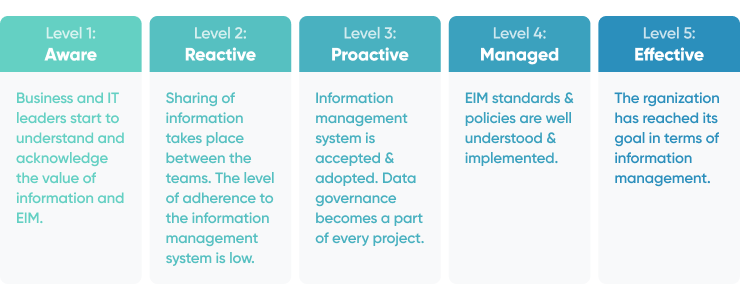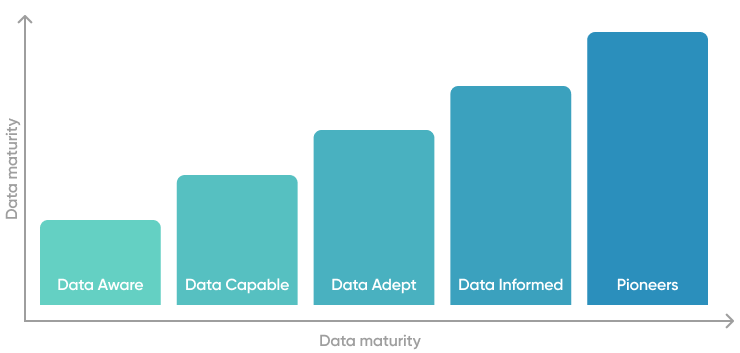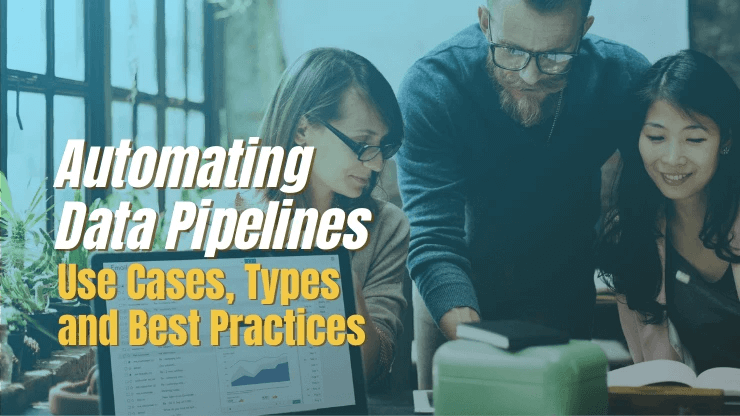Data is one of the most valuable assets that a company can have today. Harnessing the full potential data offers can offer a wealth of benefits. You’d be surprised how many companies fall down on making the most out of data, so read on to find out how you can jump ahead of the pack in that respect.
One of the best ways to do this is to understand data maturity and put yourself on the right path to climb the data maturity scale. But which data maturity models should you choose to be able to do that? We’ve got a comprehensive guide to making the right decision on that front coming right up.
At SoftKraft, we help startups and SMEs unlock the full potential of data with Data Engineering Services. In this article, we’ll explain exactly what that means and how it can help you with your own projects.
What is data maturity?
Data maturity is a measurement that demonstrates the level at which a company makes the most out of their data. To achieve a high level of data maturity, data must be firmly embedded throughout the business and fully integrated into all decision-making and activities.
The ‘maturity’ part of the phrase ‘data maturity’ is directed at a company. If a company is mature with their data, it means that they utilise their data effectively to ensure that they are getting the best out of it, and they do this in a responsible way that maximises security for the people or business whose data they are handling.
The types of data can be specific to an individual (including personal details such as age, address, contact information) or metadata that explains how long visitors visit a web application, how they interact with it (what they click on etc.) and how likely they are to return. These are just some examples of numerous groups of data that can be essential to businesses.
But why’s it important? Think about the big tech companies out there: Facebook, Google, Amazon. All of these companies have got to the top of the game through data. They know exactly what their customers like to browse on, what they are likely to interact with and how long they will interact with certain items for.
These pieces of information are invaluable to the success of these organisations because it means that they can develop a more personalised product or service at the end of the day, therefore satisfying the consumer and guaranteeing that they will come back for more. At the same time, they will (in most cases) look after this data securely so that it does not fall into the wrong hands.
While it might not be on the same scale, being data mature can have a huge impact on the success of a business of any size. So, it’s important to understand the different ways that we can be data secure. One of the best ways to do this is through data maturity models.
The Many Types of Data Maturity Models
Data maturity models are frameworks that businesses or individuals can use to ensure that they are making the most out of the data that they have. There are tonnes of different data maturity models out there, because there are a lot of different types of data.
Having an understanding of the most popular data maturity models can help you to classify and sort through your own data. So, let’s take a look at some of those right now. It’s also worth noting that companies should not just aim to use one of the following models in most cases. A combination of several is likely to get the best results.
The Dell Data Maturity Model

Perhaps the most popular data maturity model of all is the Dell model. It��’s effectively a way to rank a business on how good they are with their data using a star system from one to four stars.
The model breaks down what each of those levels are and defines what a company must be doing to reach each of the four levels. They look a bit like this:
Data Aware - To reach the entry level of the Dell data maturity model a business will have to compile any reports and forms manually. Being aware of data is about as basic as your relationship with data can be.
Data Proficient - The second level begins to demonstrate more automated processing of data and a clearer understanding of what that data can do.
Data Savvy - A companies’ self-awareness of their data reaches new heights here as they will have to use the data to make decisions that can have a huge impact on their business.
Data Driven - The biggest tech companies in the world and the smartest of CEOs will strive to reach this level. At this point, data is everything. Not a single decision is made in the business without data being involved here.
Naturally, businesses are going to want to find themselves on level four. This might not always be possible due to the nature of the business, but going as far up the scale as you can is never going to be a bad idea.
Using the Dell data maturity model can be recommended for the vast majority of companies.
The Gartner Data Maturity Model

A slightly more modern yet still helpfully generic data maturity model is that of Gartner, first presented in 2008. Similarly to Dell, this model defines levels that a company can strive to be at to get the best out of their data maturity.
This one sets out company procedure a little more specifically than Dell so could be useful when explaining the data policy of a company to an employee, a shareholder or in fact a customer. Let’s take a look at the five levels, if we ignore level 0 as it does not actually help with data.
Level 1: Aware - The very first stage of the acknowledgement of data whatsoever. Very basic usage of data to assist the company on the most fundamental level.
Level 2: Reactive - The first proper step of engagement with the data. Teams begin to share data with one another at this stage, but not a huge amount more happens here.
Level 3: Proactive - Companies can begin to put themselves on the front foot at this stage. A company will have an information management system that they can use to improve a product or service.
Level 4: Managed - Enterprise information management (referred to as EIM) is mastered here. The policies that EIM sets out explain how to maximise data usage and security, and a company will know this like the back of their hands at level 4.
Level 5: Effective -A company has maximised its efficiency with data handling and usage. No more can be done to better where they currently are. Not many companies can honestly say that they have reached this level.
If these stages seem to make more sense to you and your business, you could use these instead of the Dell model as inspiration to climb the data maturity scale.
Snowplow Data Maturity Model

The company Snowplow offers a more modern definition of data maturity and a slightly different framework for how to climb the data maturity scale. You might have noticed that there is a lack of information on the graph below, and that’s because Snowplow views the different stages in a slightly more fluid sense than the other models we have looked at so far.
That being said, Snowplow does offer some information as to what each of the levels mean to them. They also go a little further than the other models by definition ‘Pioneers’ as one of the levels. Let’s take a look at what that means and find out if it is possible to get there ourselves.
Data Aware - companies here will know a little bit about data but not do an awful lot with it.
Data Capable - here, we’re beginning to warehouse some data and notice the limitations of an analytics platform.
Data Adapt - at this point, your company is joining data together from multiple sources and modelling the data much more accurately.
Data Informed - this penultimate stage sees real time data processing in use and perhaps even building data products and operationalising them.
Pioneers - the customers of this company will see a highly personalised experience, just like the big tech companies we talked about earlier on. In terms of employment, they know exactly what it takes to find the right people with the right skills.
| Data Aware | Data Capable | Data Adept | Data Informed | Pioneers | |
|---|---|---|---|---|---|
| Current Situation | No data warehouse Some standardized reporting, but data and reports siloed Reports live in spreadsheets Using Google Analytics | Warehousing some data Analytics platform used for wider reporting & analysis "Hero" use-casrs of data, but siloed into teams Running A/B tests | Join data from 2+ sources? for single customer view Build custom models to uncover new insights Single source of truth Data driving core product Exploring ML models | (Real-time) data used to build data products & support teams Very high level of data maturity critical to success Exploring multi-cloud Hero uses of ML in operation | Highly personalized experience for all users Focus on automating and maintaining infrastructure Data easy to discover/use Custom infrastructure Operationalize (real-time) ML |
| Data & analytics challenges | Limited by people, budget & tech Need to define business goals around data | Noticing limitations of analytics platform Waste time preparing data, slow "insights to action" Low trust in data No single source of truth | Modeling data across org Keeping pipeline running smoothly, data orchestration Creating shared data vision & socializing data Data governance & compliance | **Operationalizing data projects, i.e. ML Stakes much higher around latency, data quality, etc. Data governance & compliance | Finding people with right skills Tools/tech don't exist- must build custom tools Data security |
| Data team | (Senior) Analysts, part of other teams. No dedicated data resource | Small team of analysts "Data evangelist" in org Data engineering resources | Growing team of analysts, scientists & engineers w/HOD Decentralized: analysts/data scientists across teams | Several data team leads with dedicated teams | Engineering focused (data engineers, infrastructure engineers ) |
Royal Society DELVE Model
The Snowplow model certainly helps to bring a further level of clarity to what it means to climb the data maturity scale, above and beyond that of Dell and Gartner. But, we’ve got one more model to look at today that we feel is as important as the rest, and it's the Royal Society DELVE model.
In this model, there are five levels once again.The levels rise at similar rates to the other two models, but the Royal Society gives a slightly different definition to each level. You’ll notice, for example, that the definition of ‘Reactive’ is quite a bit different to The Gartner model, and is at a different stage of the journey.
That does not mean that the DELVE model is necessarily more elevated, it’s just a different angle. Check out the table below to find out more about the Royal Society’s DELVE model’s interpretation of the data maturity scale.
| Maturity Level | Data Sharing |
|---|---|
| 1 Reactive | Data sharing is not possible or ad-hoc at best. |
| 2 Repeatable | Some limited data service provision is possible and expected, in particular between neighboring teams. Some limited data provision to distinct teams may also be possible |
| 3 Managed and Integrated | Data is available through published APIs; corrections to requested data are monitored and API service quality is discussed within the team. Data security protocols are partially automated ensuring electronic access for the data is possible. |
| 4 Optimized | Teams provide reliable data services to other teams. The security and privacy implications of data sharing are automatically handled through privacy and security aware ecosystems. |
| 5 Transparent | Internal organizational data is available to external organizations with appropriate privacy and security policies. Decision making across the organisation is data-enabled, with transparent metrics that could be audited through organisational data logs. If appropriate governance frameworks are agreed, data dependent services (including AI systems) could be rapidly and securely redeployed on company data in the service of national emergencies. |
Which factors are most influential in enabling data maturity?

Now that we know what the stages look like, it’s a good idea to check out which factors of a company’s behaviour (including your own) will apply to each stage so that you have an even clearer idea of what it takes to climb the data maturity scale.
Here are the most important factors. You’re going to want to nail these!
Culture - the way that you handle your team, and encourage them to share, protect and utilise data is perhaps the most important of all. Teamwork is super important in enabling data maturity.
Data - this one might seem obvious, but the type of data that you use, the sources you receive it from and the quality of it are crucial.
Tools - the software that you use to collect your data has a direct effect on the quality of your data. On top of this, you’ll need to consider storage.
Uses - now that you have all of your data, how are you going to implement it for the better of your company?
Analysis - the techniques that you use to analyse your data comes in here. The best data in the world becomes useful if you don’t look at it in the right ways.
Skills - your personal skills set and that of your team is important to get the rest of the system running smoothly.
Leadership - the attitude of the leader, the way they run the budget, how they organise the team and more is the highest cog in the mechanism.
How to Climb the Data Maturity Scale?
So, we’ve checked out what the data maturity scale looks like to different people and developed our own sense of it from those four models. We’ve also taken a look at the key factors involved with rising through it.
But, how do we actually use those factors to climb the data maturity scale? Here are some top tips on increasing your data maturity:
Figure out any business alignment issues
Having a data strategy is one thing, but if it is chosen from thin air and does not align with the strategy of your business, it’s going to be a waste of time. Choosing the right data maturity model, data analysis tools and data itself to suit your business is key.
Get the right personnel on your team
Data does not just belong to the IT department like a lot of people seem to think. You’ll need to ensure company-wide engagement when it comes to data maturity, and this starts with choosing the right people.
Communication is key
After you’ve got the right people, you’ll need to make sure that you are communicating your data strategy to those team members and that those team members are effectively sharing data and strategy between each other.
Finesse data management at every stage
But data management comes from the top. Poor data quality, irresponsible handling of data and simple time wasting are all symptoms of bad data management, and these are all things you are going to want to avoid at all costs.
How do organizations benefit from data maturity?
With this information, we’re only a few steps away from rising through the ranks of the data maturity scale and seeing the results roll in. What do the results look like, though? How do we benefit?
It might seem obvious by this point, but there are probably a few benefits that you have not come to consider just yet. Take a look at these, as they may be that final motivation you need to correct the data maturity at your organization and climb the data maturity scale:
- Money saving from efficiency
- Heightened security
- Credibility and brand image increased
- Partnerships with other businesses strengthened
- Outcomes and impact increased
- Better products and services
- Better awareness, improved learning
All of these overall will lead to increased income, and that is, of course, the main thing we are looking for in our businesses.
Conclusion
Understanding data maturity and how to climb the data maturity scale can bring a whole new dimension to your business, not just with how it uses its data but how the company performs as a whole.
Reach out to Softkraft today to see how we can help you with your own data management needs. It really could be the difference between the ongoing success of your organization or not! We’ve helped tonnes of companies climb the data maturity scale, so check in with us to find out how we can do the same for you.







